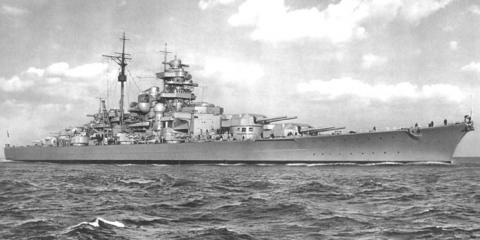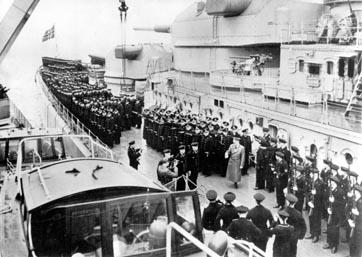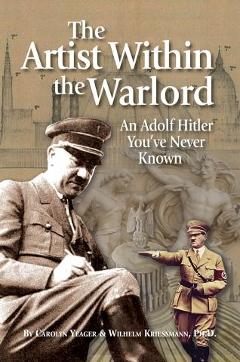Anglo-German Naval Agreement of June 18, 1935

The great battleship Bismarck was launched on Feb. 14, 1939 at Hamburg.
Adolf Hitler proclaimed June 18, 1935 the happiest day of his life. It was because the naval agreement his government sought with Great Britain, the A.G.N.A., was signed. Hitler saw it as the beginning of an alliance between the two nations against France and the Soviet Union—the beginning of the partnership that he was seeking between the “leading” nations of Europe: Germany and England. These two, Great Britain by sea and Germany by land armies, would share the burden of defending Europe from all enemies.
It also released Germany from the Treaty of Versailles in the area of naval rearmament. Under the 1919 treaty, Germany was allowed no submarines, no naval aviation, and no battleships. The total naval forces allowed to the Germans were six each heavy and light cruisers, 12 each destroyers and torpedo boats.
Germany had continued through the years to protest these restrictions, demanding that either all of Europe disarm down to German levels, or Germany be allowed to rearm to their level. Every German government of the Weimar Republic , preceding Hitler's Third Reich, had been implacably opposed to the terms of Versailles; the British were well aware that the terms were unjust, unstable and indefensible. It was France that always vetoed any relaxation.
Deep cuts that were made to the Royal Navy, imposed by two conferences, combined with the effects of the Great Depression caused the collapse of much of the British shipbuilding industry in the early 1930s. Thus, the Admiralty valued treaties which imposed quantitative and qualitative limitations on potential enemies as the best way of ensuring British sea supremacy--not something that Britain considered negotiable.
Hitler, from1933 onwards, requested a Reichsmarine one-third the size of the Royal Navy, which was then changed to 35% to make it all come out more evenly. Britain's Admiral Chatfield advised it would be best to have a treaty in order to regulate the future size and scale of the German Navy, and stated that a 35:100 tonnage ratio between London and Berlin was “the highest that we could accept for any European power.”
Germany had already started to build its first U-boats again in 1933, and launched the first ones in April 1935. On May 2, the Prime Minister Ramsay MacDonald told the House of Commons of his government’s intention to reach a naval pact to regulate the future growth of the German Navy. On May 21, Hitler gave a “peace speech” in Berlin formally offering to discuss a treaty with a German Navy that was to operate forever on a 35:100 naval ratio, disallowing any intention of engaging in a pre-1914 style naval race with Britain.
“The German Reich government recognizes of itself the overwhelming importance for existence and thereby the justification of dominance at sea to protect the British Empire, just as, on the other hand, we are determined to do everything necessary in protection of our own continental existence and freedom.”
For Hitler, his speech illustrated the equality of status in an Anglo-German alliance, namely British acceptance of Germany's dominant position in continental Europe in exchange for German acceptance of British dominance over the seas.
* * *
The Pact was signed in London on June 18 without any consultation with France and Italy. Hitler became annoyed, however, when the A.G.N.A was not followed up with further expressions of alliance between the two countries. By 1937, he started to increase both Reichsmarks and raw materials to the Kriegsmarine; in December, he ordered the laying down of six 16-inch gun battleships. By 1938, the only use the Germans had for the A.G.N.A. was to threaten to renounce the treaty as a way of pressuring London to accept continental Europe as Germany's rightful sphere of influence.
In January 1939, Hitler gave first priority to the Kriegsmarine in the allocation of money, skilled workers, and raw materials. He launched the Plan Z to build a colossal Kriegsmarine of 10 battleships, 16 "pocket battleships", 8 aircraft carriers, 5 heavy cruisers, 36 light cruisers, and 249 U-boats by 1944. Since the fleet envisioned in the Z Plan was larger than that allowed by the 35:100 ratio in the A.G.N.A, the Z Plan made it inevitable that Germany would renounce the A.G.N.A.
In response to the British guarantee of Poland of March 31, 1939, Hitler, in a speech in Wilhelmshaven for the launch of the Admiral Tirpitz battleship, threatened to denounce the A.G.N.A. if the British persisted with their encirclement policy as represented by the guarantee of Polish independence. On April 28, in a speech before the Reichstag, Hitler did renounce both the A.G.N.A. and the German-Polish Non-Aggression Pact.
On Britain's side, Chatfield, who originally had recommended the treaty, commented at a Cabinet meeting on May 3, 1939 that Hitler had “persuaded himself” that Britain had provided the Reich with a “free hand” in Eastern Europe in exchange for the A.G.N.A. In a later paper to the Cabinet, Chatfield stated
“that we might say that we now understood Herr Hitler had in 1935 thought that we had given him a free hand in Eastern and Central Europe in return for his acceptance of the 100:35 ratio, but that as we could not accept the correctness of this view it might be better that the 1935 arrangements should be abrogated.”

Adolf Hitler made a surprise visit to Gotenhafen on 5 May 1941 to inspect the Bismarck and Tirpitz (which had recently arrived to conduct her sea trials in the Baltic) and be briefed on Admiral Günther Lütjens' plans for executing the forthcoming sortie, although the actual date was kept vague.
Category
Adolf Hitler, European History, Germany, World War II- 6300 reads









